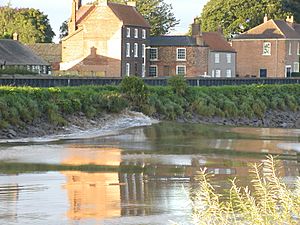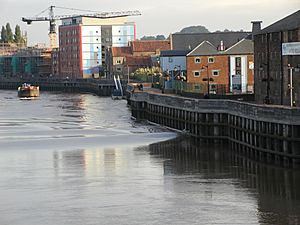Trent Aegir facts for kids


The Trent Aegir, also called the Eagre, is a special type of wave that travels up the River Trent in England. This wave is known as a tidal bore. At certain times of the year, the part of the Trent where the ocean's tides reach can experience a fairly large wave. This wave can be up to five feet (about 1.5 meters) high! Some people think its name comes from Ægir, a sea god from Norse mythology. However, it's more likely that the name comes from an old English word, ēagor, which means "flood" or "water."
Contents
What Causes the Trent Aegir?
The Aegir happens when a very high spring tide from the ocean meets the normal flow of the river moving downstream. The mouth of the River Trent is shaped like a funnel. This shape makes the incoming tide even bigger, causing a large wave to travel upstream. This wave can go as far as Gainsborough, Lincolnshire, and sometimes even further!
Why the Aegir Stops
The Aegir cannot travel much beyond Gainsborough. This is because the river's shape changes, making the Aegir smaller and smaller until it's just a tiny ripple. Also, there are weirs (small dams) north of Newark-on-Trent, Nottinghamshire. These weirs completely block the Aegir's path, stopping it from going any further up the river.
Where Can You See the Aegir?
You can often see the Aegir in several places along the River Trent. Good spots include Gainsborough, Morton, East Stockwith, West Stockwith, and Owston Ferry.
Finding Aegir Predictions
In the past, the Environment Agency used to tell people when the Aegir was expected. They don't do this anymore. However, you can sometimes find predictions for the Aegir on websites like Crowle.org. The United Kingdom Hydrographic Office (UKHO) also offers helpful information about tidal predictions. They even have a free service that shows tidal times for the upcoming week.
Historical Mentions of the Aegir
There's a story that King Cnut tried to command the tide to stop in the River Trent at Gainsborough. If this story is true, it's very likely that King Cnut was trying to stop the powerful Aegir wave.
The Aegir also appears in a famous book! It's mentioned in George Eliot's novel, The Mill on the Floss, which was written in 1860. In the book, it says: "Above all, the great Floss, along which they wandered with a sense of travel, to see the rushing spring-tide, the awful Eagre, come up like a hungry monster." This shows how impressive and a bit scary the Aegir could seem to people.

